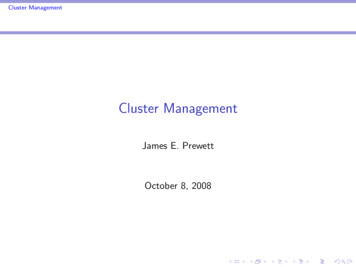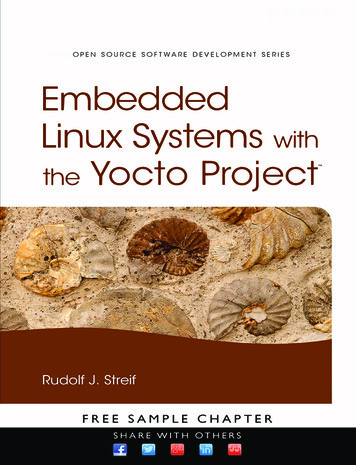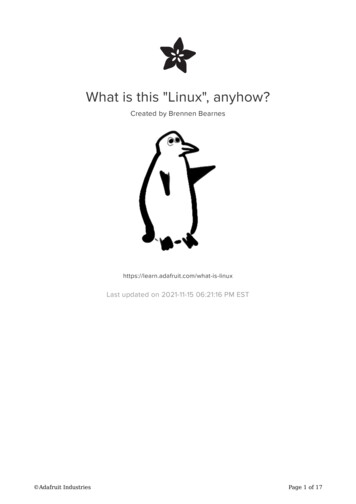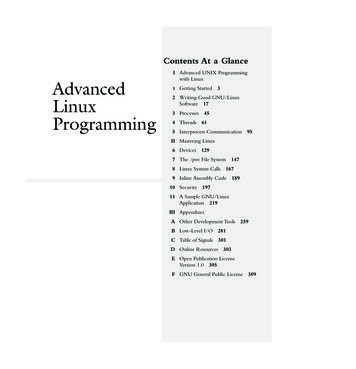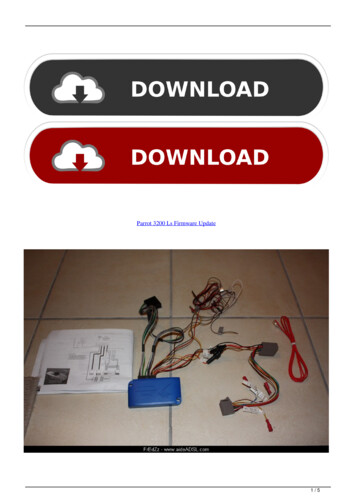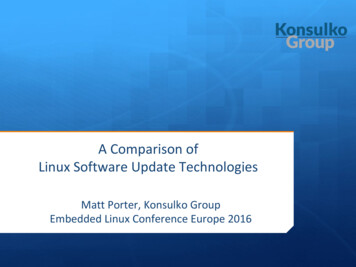
Transcription
A Comparison ofLinux Software Update TechnologiesMatt Porter, Konsulko GroupEmbedded Linux Conference Europe 2016
Overview Background of Linux software update Linux software update strategies Detailed look at each FOSS project Strategy employed Other features Maturity Community Downstream projects
Linux software update history H.J. Lu’s Boot-root distributions Boot and build the rest, no updatemechanism MCC, TAMU, and SLS Packages in tarballs, no dependencies Slackware Packages in tarballs, no dependencies Per release scripted updates, flaky if too old
Linux software update history Debian, Red Hat Linux / Fedora, SUSE Modern deb or rpm package managementwith complete set of dependencies Non-atomic incremental updates Release updates by designating a set ofpackage versions Driven by complex set of pre/post installscripts which can leave updated systems in anon-working state.
Linux software updaterequirements There are many requirements Tradeoffs are unique foreach product. No exact steps onlyguidelines Power fail safe? Frequent/infrequent updates? Bandwidth of update deliverychannel vs. size of updates? Speed of update? Verification/Authentication?
Linux software update strategiesTraditional method Traditional non-atomic package-based releases Package based granularity with dependencyhierarchy apt and yum based updates may require luckor other methods for reliability. Unacceptable for the embedded zoo.
Linux software update strategiesFull image updates Has been the standard approach since Linux inembedded systems was popularized. Single image approach assumes the new updatewill boot Recoverable if update can be performedfrom an immutable mechanism (fallbackfactory bootloader) Dual image approach is inherently atomic Bootloader will fallback to previouslyworking image on failure of update Update speed relative to size of full image
Linux software update strategiesFull image updatesCompletely unrealistic and simplified dual image exampleBootloader1) Boot active image3) Toggle B active andA inactive. Reboot.Linux image A(active - inactive)2) Receive and install update topartition B.4) Boot new active image B.Fallback to A if boot fails(typically using watchdogand/or heartbeat).Linux image B(inactive - active)
Linux software update strategiesIncremental atomic updates The new kid on the block that does crazy stuff,likely to be called balderdash by the old guard. Driven initially by server needs Incremental atomic upgrades that can bequickly deployed or rolled back on demand. Complete history of deployments Releases are composed of binary deltas Not a package granularity Deltas are per file modified Size of updates are minimized
Linux software update strategiesContainers Not usually a complete upgrade solutionBuilt on top of a core immutable distributionApplications only exist in a container instanceUpdates rolled out in container deltas
SWUpdate Single or dual image update framework https://github.com/sbabic/swupdate Written in C. GPL2 license. Attempt to be modular with plugins Supports signed images, local/remoteupdates, and U-Boot. meta-swupdate layer for Yocto Project Has several contributors besides original author Used at least by Siemens (http://sched.co/7rrA)and Stefano’s own projects
SWUpdate Updates delivered in simple CPIOarchive Each individual image is described insw-description and integrity is validatedwith a SHA256 hash. Handler plugins implement the details ofhow each described image is handled. U-Boot env update NOR, NAND, UBI partition and write MMC/SD/eMMC partition and write Custom installers can enable FPGAbitstream or uC firmware updates
SWUpdate sw-descriptions can be extended using customLUA parsers to support new features multiple hardware platforms in one image Configuration file support via libconfig or XMLformat by default Uses Kbuild for configuration Supports Mongoose web server and RESTinterface to Hawkbit server for remote update Strange stuff exists like an implementation of auserspace GPIO library that duplicates otherprojects.
mender.io Dual image update framework https://github.com/mendersoftware/mender Designed as a client/server systemfor OTA updates. Written in Go.Apache 2 license. meta-mender layer supportsbuilding the client into a deviceimage using YP/OE https://github.com/mendersoftware/meta-mender Project contributors areoverwhelmingly represented byMender employees.
mender.io Two client modes Standalone - updates are triggered locally(suitable for physical media or any networkupdate in pull mode) Managed - client is a daemon and will poll theserver for updates. mender’s dual image or “A/B” scheme uses anotion of “commit” when and update has bootedproperly. On failure it will toggle the inactive/activepartitions as with a standard dual image approach
mender.io QEMU and BeagleBone Black reference platforms That’s the bee’s knees for getting started easily As a complete demonstrable solution, menderrelies on some assumptions: U-Boot Boot Count Limit, ext2/3/4fs, and Linuxenv tools, and a specific U-Boot configuration systemd (and required kernel config options) formanaged mode a fixed layout of U-Boot in one partition, apersistent data partition, and two A/B partitionswith rootfs/kernel.
mender.io Does not support raw NOR, NAND, UBI partitionsand volumes. Excellent documentation on use and customization. Ready to use platforms to test operation. Established project CI loop. Test/QA tools all available freely.
OSTree Incremental atomic upgrade mechanism https://github.com/ostreedev/ostree Self-described as “git for operating systembinaries”. Uses a git-like object store to record and deploycomplete file system trees using binary deltas. Depends on an immutable filesystem hierarchyfor the updated root re/systemd/TheCaseForTheUsrMerge/) Persistent data kept in /etc
OSTree How does it work? Target has a local copy of a repository in/ostree/repo Target has any number of “deployments”stored in /ostree/deploy A deployment is stored physically in/ostree/deploy/ OSNAME/ CHECKSUM anduniquely identified with a SHA256 checksum Each deployment has its own copy of /etc Activation requires a reboot
OSTree Deploy and rollback ostree-admin-upgrade ostree-admin-deploy {REFSPEC} ostree-admin-status ostree-admin-undeploy {INDEX} Atomic updates are guaranteed by atomicallyswapping a /boot symlink to a new deployment/ostree/boot.foo directory A bind mount is established at boot timepointing to the currently deployed filesystem.
OSTree There are many projects that have adoptedOSTree Gnome tinuous Project Atomic http://www.projectatomic.io/Flatpak https://github.com/flatpak/flatpakPulp Platform https://github.com/pulp/pulp ostreeAutomotive Grade 194 https://git.automotivelinux.org/gerrit/gitweb?p AGL/meta-agl-extra.git;a summary
swupd Incremental atomic upgrade mechanism Originally part of ClearLinux project github.com/clearlinux/swupd-server Functionality is very similar to OSTree. Updates are delivered as a stream of bundlescontaining binary filesystem deltas. meta-swupd supports YP/OE target imagebuilds pd
swupd Key difference is that the swupd-client does notrequire a reboot to activate a newly releasedbundle swupd-server tool handles creation of bundlesand feed update streams to a client. Project shows no contributors outside of Intel Only projects adopting swupd are ClearLinuxand Ostro OS, both Intel projects.
Container-based solutions Resin.io Base OS is flexible, Docker-based deltas Ubuntu Snappy Base OS is minimal Ubuntu with deltaedcontainers Project Atomic Base OS managed with OSTree,Docker-based deltas Focus on application and middleware update
Related sessions Generic System for Safe Upgrades Tuesday 10:00 http://sched.co/7rrp ResinOS Tuesday 15:00 http://sched.co/8PTZ OSS Remote update for IoT Devices Tuesday 15:00 http://sched.co/7rrA Mender.io BoF Tuesday 18:10 http://sched.co/8PeA Continuous Delivery with Yocto (Ostro) Wednesday 10:45 http://sched.co/7rrB Software update for IoT Wednesday 14:00 http://sched.co/7rrJ Software updates for connected devices Wednesday 15:00 http://sched.co/7rrK
Q&A
Linux software update strategies Full image updates Completely unrealistic and simplified dual image example Linux image A (active - inactive) Linux image B (inactive - active) Bootloader 1) Boot active image 2) Receive and install update to partition B. 3) Toggle B active and A inactive. Reboot. 4) Boot new active image B. Fallback to A if .





